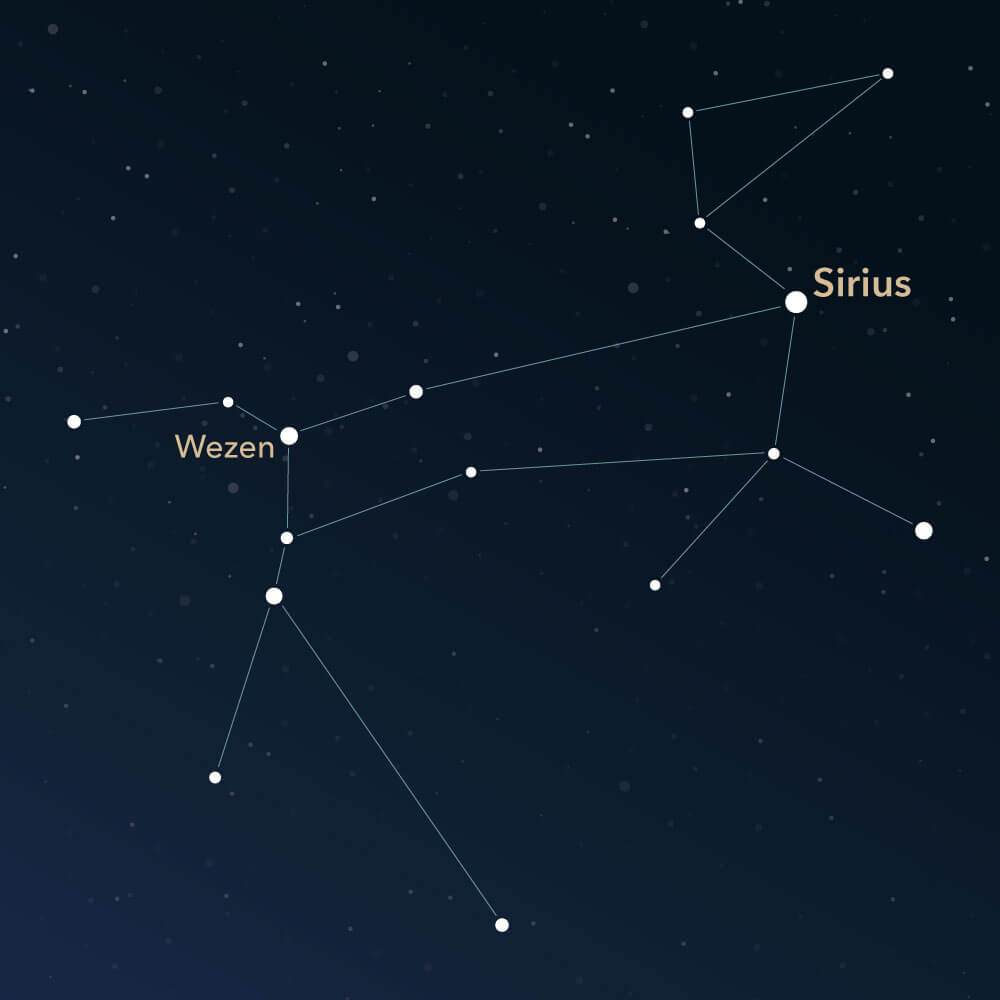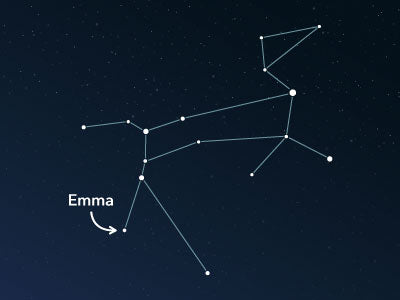The constellation Canis Major
Characteristics
- Other names / Symbolism
- Greater Dog
- Hemisphere
- Southern hemisphere
- Visibility
- November - April
- Area
- 380 deg²
- Brightest star
- Sirius (HIP number 32349)
- Specialties
- Open star clusters, emission nebula

Canis Major, Latin for Greater Dog, is one of the 48 constellations described by the Greco-Roman astronomer Claudius Ptolemy in ancient times. In addition to featuring the brightest star in the night sky, the constellation includes some interesting deep-sky objects.
Hemisphere, visibility, and area
Canis Major lies in the southern sky and is visible from all regions of the southern half of the globe. North of the equator, it is visible up to the 57th parallel, roughly corresponding to locations such as Riga in Latvia or Aalborg in Denmark.
The best months for observing the constellation from the southern hemisphere are from November to April. From the northern hemisphere, it can only be seen between December and March, appearing just above the horizon.
The constellation covers an area of about 380 square degrees, ranking it in the middle among all 88 constellations.
There are different visualizations of Canis Major. Some connect only the brightest stars, forming a curved line, while other representations include more stars, resulting in a complete dog shape.
Locating the constellation in the night sky is not difficult due to a series of very prominent stars, especially one that stands out.
Sirius (Latin: α Canis Majoris, Alpha Canis Majoris) is not only the brightest star in Canis Major, but also the brightest star in the entire night sky. It is a double-star system with an apparent magnitude of about -1.5. Sirius is estimated to be about 240 million years old, making it a relatively young star system.
To find Canis Major in the sky, it is also helpful to look for adjacent constellations. The neighboring constellations include Monoceros, Lepus, Columba, and Puppis.
The prominent Orion does not directly border Canis Major but is nearby. Canis Major is located southeast of this constellation.
Specialties in the constellation
The Milky Way runs through the western part of Canis Major, resulting in several open star clusters in the constellation. A well-known emission nebula can also be observed.
One of the open star clusters is M41 (Messier 41), also known as the Little Beehive Cluster. The designation M41 comes from the French astronomer Charles Messier, who included it in his catalog of nebulous objects.
M41 is located below the star Sirius and can be seen with the naked eye due to its size. In a small telescope or binoculars, around 40 individual stars are visible, while a large telescope can reveal up to 100 stars. It is estimated to be 2,400 light-years away.
Further south, near the star Wezen, is the even brighter star cluster NGC 2362, also known as Tau Canis Majoris Cluster. It is about 4,400 light-years away and one of the youngest open star clusters in the Milky Way. This star cluster can be observed with binoculars or a small telescope.
An emission nebula is also located in the area of Canis Major. NGC 2359, known as the Duck Nebula, was discovered by the German-British astronomer William Herschel in 1785 and cataloged in 1877. It lies approximately 15,000 light-years away and appears as a white-blue nebula with a reddish glow on edge.

Mythology
Canis Major is a classic constellation of antiquity with various descriptions. One account states that it represents the hunting dogs of Orion, along with Canis Minor.
As early as the 3rd century BC, Canis Major was described as the guard dog of Orion. In the poem "Phainomena," the poet Aratus of Soli says how the dog, holding Sirius in its mouth, loyally follows Orion on its hind legs.
According to the story of the Greek astronomer Eratosthenes of Cyrene, the constellation represents the dog Lailaps. Lailaps was an exceptionally fast hunting dog that never let its prey escape. At first, Zeus gave the dog to his lover Europa. Later, her son Minos gave the dog to Princess Procris of Athens. Princess Procris married the hunter Cephalus, who unfortunately killed her while hunting. He mistook his wife for a deer and stabbed her with his spear.
As a punishment, Cephalus was banished to the Greek city of Thebes, where an enchanted fox was causing great damage by hunting livestock and wild animals. The fox could not be caught due to a divine spell. Cephalus wanted to help the desperate inhabitants of Thebes and set his special dog Lailaps on the fox. However, even Lailaps could not catch it.
Ultimately, Cephalus gave up the unsuccessful hunt and set his dog Lailaps as a constellation in the sky.
The Egyptians and Romans interpreted Canis Major differently. While in Egypt, the constellation was interpreted as the embodiment of the jackal-headed god of the dead, Anubis, the Romans saw in Canis Major, the guard dog of the underworld. The guard dog of the underworld was named Cerberus and always allowed anyone to enter the underworld but never let anyone out.
PublishedRead more interesting articles

An overview of all 88 constellations
Learn more about all 88 constellations and read interesting information about the mythology, visibility, and features.

Planetarium App
Discover the night sky with our planetarium app!
Available for iOS and Android.

Name a star in the constellation Canis Major
Name a star in a constellation and create something that lasts for eternity.